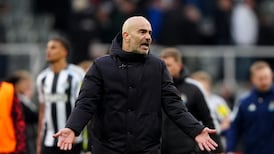RUGBY: The IRFU, and by extension the Irish rugby community, were last night feeling let down by the Government's U-turn on the proposed National Stadium. The union now seem further away than ever from their goal of having an adequate venue for international rugby matches in the long term.
The union had remained committed to the Abbotstown project and are left with the alternatives of building a new stadium at its Newlands Cross site or redeveloping Lansdowne Road. Both options are decidedly more prohibitive than when they were abandoned on foot of the Government's assurances about Abbotstown.
"We're pretty disappointed with it, to put it mildly," said IRFU chief executive Philip Browne, in reference to the Government statement. "We had been led to believe that the National Stadium would fulfil our needs for international matches and that it was definitely going to go ahead.
"If it's not going to go ahead then clearly, we're going to have to consider our options, which is effectively back to where we started from a few years ago, namely Newlands Cross or Lansdowne Road. That is a pretty unpalatable thought, to be honest with you," said Browne.
"The reality is that if we have to fund the building of a new stadium then it's going to impact on our ability to run the game, particularly the professional end, because most of our revenue would have to be diverted into funding a new stadium."
The cost of funding the professional game will be about €17 million this year alone, and rising.
A feasibility study into building an all-seater, 60-65,000 capacity stadium on the union's 90-acre Newlands Cross site was conducted seven years ago, and it was estimated then it would cost the IRFU over £100 million, a figure which could probably now be doubled.
"Estimates from seven or eight years ago are meaningless," said Browne. "That's one of the difficulties we now face. Because of all the delays in the Solar Centre and the National Stadium, the reality is building costs have escalated greatly since then."
The cost of redeveloping Lansdowne Road would be even greater as the existing stadium would first have to be demolished.
"The difficulty with Lansdowne Road is the configuration of the site," said Browne. The ground is adjacent to both a railway line and a river, to which might be added the likely difficulties in obtaining planning permission from local residents.
The union's dilemma is compounded by the knowledge that the game here is funded by internationals. "We need to have a stadium which can maximise our potential revenue but there is a Catch 22 situation in that respect, because you could be mortgaging away your future by building a stadium."
For the time being, then, Browne said the IRFU could do little more than make the best of Lansdowne Road. As it stands, though, and set against the advent of modern, all-seater stadiums in Europe, Lansdowne Road is becoming increasingly ill-equipped to stage international rugby, or football for that matter.
"The fact of the matter is Lansdowne Road, in its current guise, has a limited life-span," said Browne.
However, the IRFU have not given up all hope of the National Stadium being built. "There's a danger in over-reacting and throwing our hands up in the air," said Browne. "We need to establish some clarity over the whole issue, to talk to the relevant Departments and to the Minister for Sport, and establish what exactly this statement means, and what they mean by private funding."
Clearly, though, the IRFU are not optimistic. Without the Abbotstown option, it's also worth noting that the option of redeveloping Lansdowne Road into a secondary all-seater stadium would no longer be viable either. That was contingent on the organisation having an alternative venue for internationals.
As for the possibility of playing Tests in Croke Park, were the latter ever made available to them, Browne declined to speculate.
Set against the Government grants of £60 million which the GAA has received, this year the IRFU received €3.75 million towards underage development of the game, and previously received separate grants of £350,000 and £300,000 towards refurbishing Thomond Park and the Sportsground in Galway.
The union were given assurances from the Government and they in turn made assurances to the Government in backing the National Stadium.
"At the end of the day the Government have clearly done their best. It's just disappointing that it's taken so long to get to this point. Time marches on. Things don't get any cheaper."
Ultimately, the IRFU would need considerable Government funding if they were to redevelop Lansdowne Road into an all-seater stadium with a capacity of at least 45,000. The most unpalatable thought of all is that they might have to sell Lansdowne Road.











